Abstract
Semisynthetic combinatorial antibody library methodology in the phage-display format was used to select for a cysteine residue in complementarity-determining regions. Libraries were panned with an alpha-phenethyl pyridyl disulfide that undergoes disulfide interchange. Out of 10 randomly picked clones, two contained an unpaired cysteine, one of which was studied. The antibody catalyzed the hydrolysis of the corresponding thioester where the electrophilic carbonyl occupies the three-dimensional space that was defined by the reactive sulfur atom during selection. The reaction operates by covalent catalysis. Although the steady-state rate enhancement relative to the activated thiol ester substrate is modest, hydrolysis of the acylated cysteine intermediate is remarkably efficient with a catalytic advantage of about four orders of magnitude. The results suggest that iterative mechanism-based selection procedures can recapitulate the enzymatic mechanisms refined through evolution.
Full text
PDF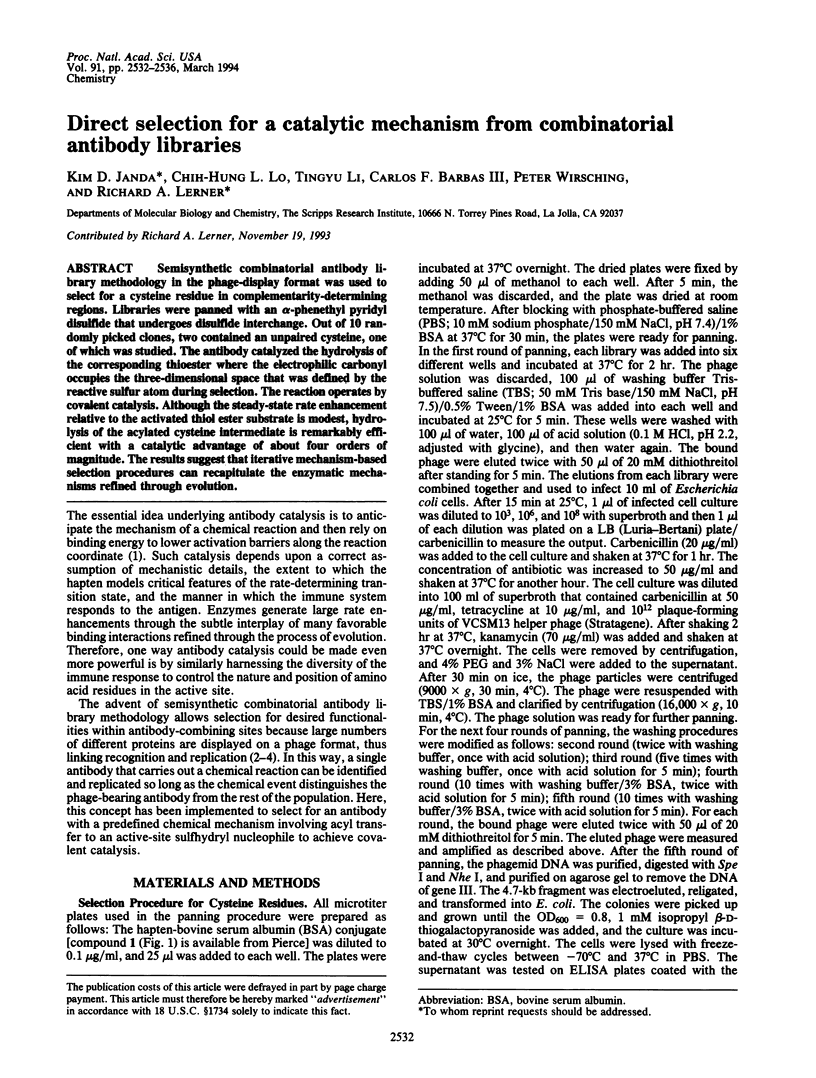
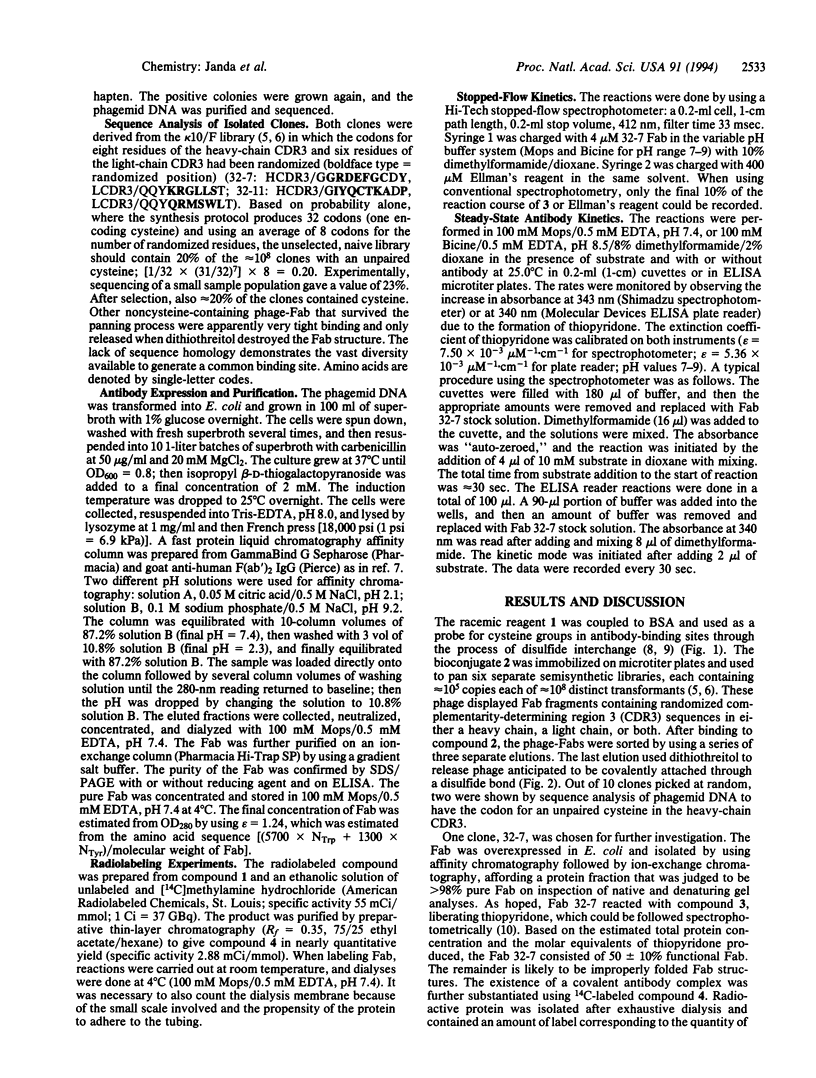
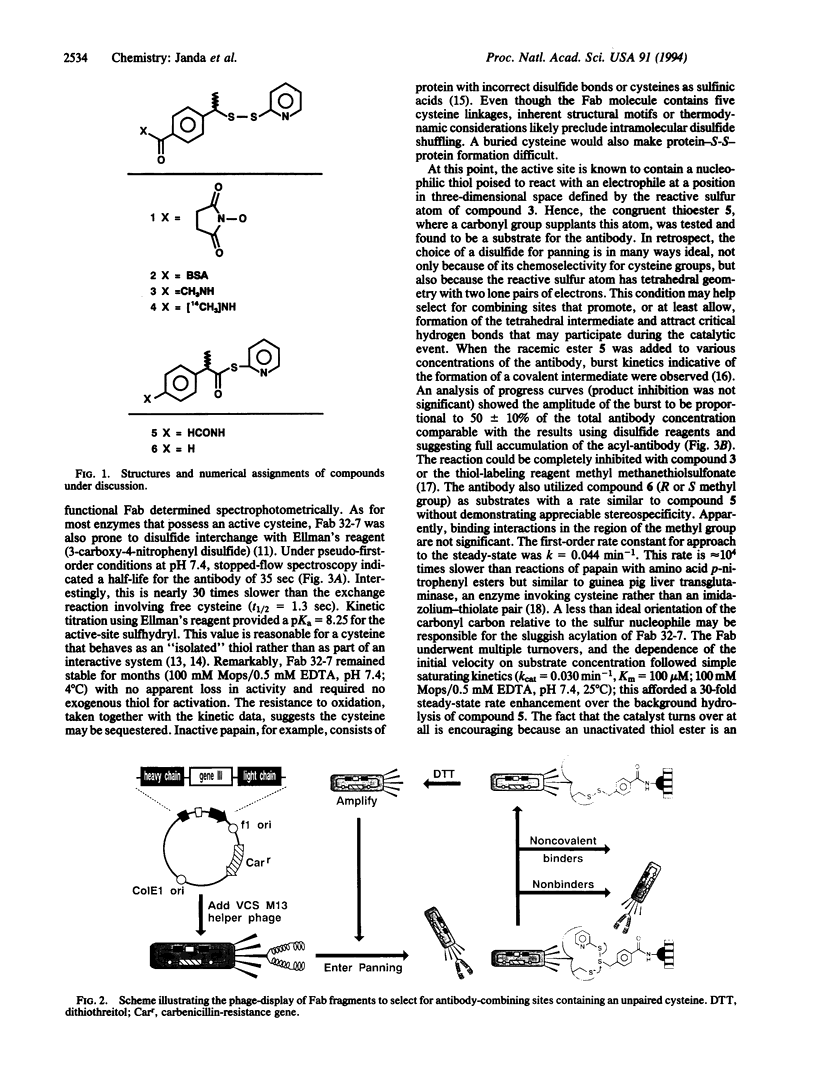
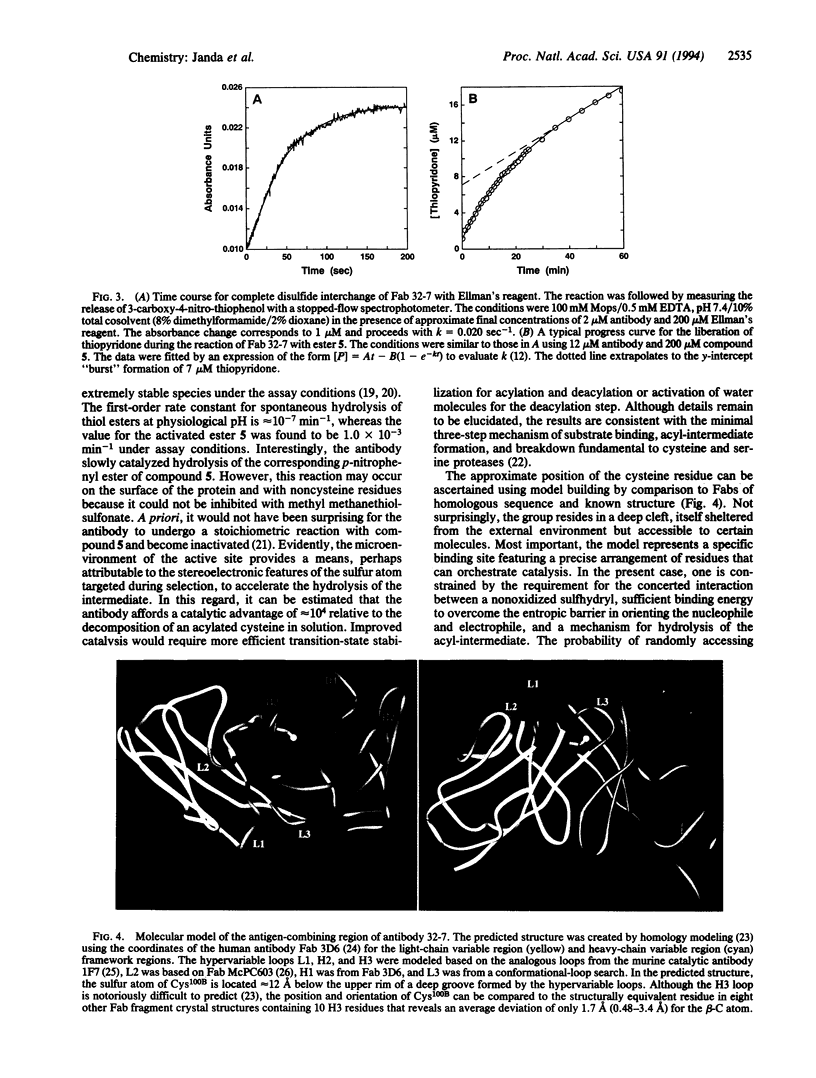
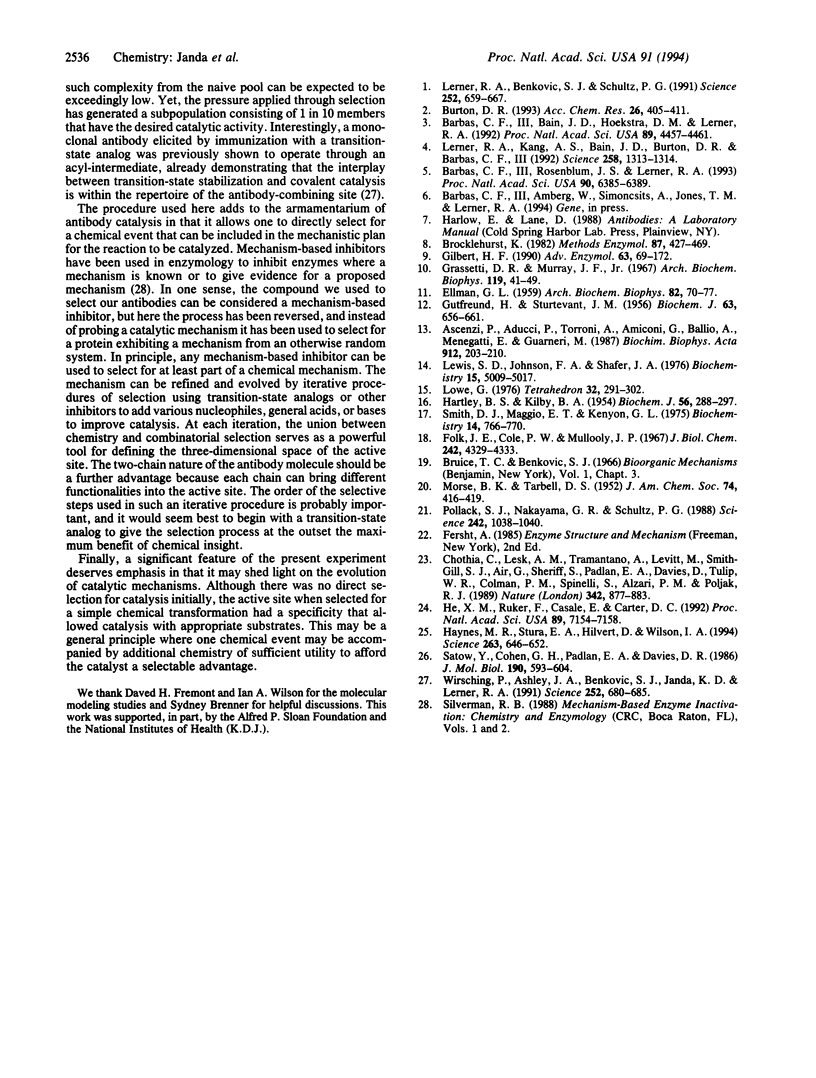
Images in this article
Selected References
These references are in PubMed. This may not be the complete list of references from this article.
- Ascenzi P., Aducci P., Torroni A., Amiconi G., Ballio A., Menegatti E., Guarneri M. The pH dependence of pre-steady-state and steady-state kinetics for the papain-catalyzed hydrolysis of N-alpha-carbobenzoxyglycine p-nitrophenyl ester. Biochim Biophys Acta. 1987 Apr 8;912(2):203–210. doi: 10.1016/0167-4838(87)90090-2. [DOI] [PubMed] [Google Scholar]
- Barbas C. F., 3rd, Bain J. D., Hoekstra D. M., Lerner R. A. Semisynthetic combinatorial antibody libraries: a chemical solution to the diversity problem. Proc Natl Acad Sci U S A. 1992 May 15;89(10):4457–4461. doi: 10.1073/pnas.89.10.4457. [DOI] [PMC free article] [PubMed] [Google Scholar]
- Barbas C. F., 3rd, Rosenblum J. S., Lerner R. A. Direct selection of antibodies that coordinate metals from semisynthetic combinatorial libraries. Proc Natl Acad Sci U S A. 1993 Jul 15;90(14):6385–6389. doi: 10.1073/pnas.90.14.6385. [DOI] [PMC free article] [PubMed] [Google Scholar]
- Brocklehurst K. Two-protonic-state electrophiles as probes of enzyme mechanisms. Methods Enzymol. 1982;87:427–469. doi: 10.1016/s0076-6879(82)87026-2. [DOI] [PubMed] [Google Scholar]
- Chothia C., Lesk A. M., Tramontano A., Levitt M., Smith-Gill S. J., Air G., Sheriff S., Padlan E. A., Davies D., Tulip W. R. Conformations of immunoglobulin hypervariable regions. Nature. 1989 Dec 21;342(6252):877–883. doi: 10.1038/342877a0. [DOI] [PubMed] [Google Scholar]
- ELLMAN G. L. Tissue sulfhydryl groups. Arch Biochem Biophys. 1959 May;82(1):70–77. doi: 10.1016/0003-9861(59)90090-6. [DOI] [PubMed] [Google Scholar]
- Folk J. E., Cole P. W., Mullooly J. P. Mechanism of action of guinea pig liver transglutaminase. IV. The trimethylacyl enzyme. J Biol Chem. 1967 Oct 10;242(19):4329–4333. [PubMed] [Google Scholar]
- GUTFREUND H., STURTEVANT J. M. The mechanism of the reaction of chymotrypsin with p-nitrophenyl acetate. Biochem J. 1956 Aug;63(4):656–661. doi: 10.1042/bj0630656. [DOI] [PMC free article] [PubMed] [Google Scholar]
- Gilbert H. F. Molecular and cellular aspects of thiol-disulfide exchange. Adv Enzymol Relat Areas Mol Biol. 1990;63:69–172. doi: 10.1002/9780470123096.ch2. [DOI] [PubMed] [Google Scholar]
- Grassetti D. R., Murray J. F., Jr Determination of sulfhydryl groups with 2,2'- or 4,4'-dithiodipyridine. Arch Biochem Biophys. 1967 Mar;119(1):41–49. doi: 10.1016/0003-9861(67)90426-2. [DOI] [PubMed] [Google Scholar]
- HARTLEY B. S., KILBY B. A. The reaction of p-nitrophenyl esters with chymotrypsin and insulin. Biochem J. 1954 Feb;56(2):288–297. doi: 10.1042/bj0560288. [DOI] [PMC free article] [PubMed] [Google Scholar]
- Haynes M. R., Stura E. A., Hilvert D., Wilson I. A. Routes to catalysis: structure of a catalytic antibody and comparison with its natural counterpart. Science. 1994 Feb 4;263(5147):646–652. doi: 10.1126/science.8303271. [DOI] [PubMed] [Google Scholar]
- He X. M., Rüker F., Casale E., Carter D. C. Structure of a human monoclonal antibody Fab fragment against gp41 of human immunodeficiency virus type 1. Proc Natl Acad Sci U S A. 1992 Aug 1;89(15):7154–7158. doi: 10.1073/pnas.89.15.7154. [DOI] [PMC free article] [PubMed] [Google Scholar]
- Lerner R. A., Benkovic S. J., Schultz P. G. At the crossroads of chemistry and immunology: catalytic antibodies. Science. 1991 May 3;252(5006):659–667. doi: 10.1126/science.2024118. [DOI] [PubMed] [Google Scholar]
- Lerner R. A., Kang A. S., Bain J. D., Burton D. R., Barbas C. F., 3rd Antibodies without immunization. Science. 1992 Nov 20;258(5086):1313–1314. doi: 10.1126/science.1455226. [DOI] [PubMed] [Google Scholar]
- Lewis S. D., Johnson F. A., Shafer J. A. Potentiometric determination of ionizations at the active site of papain. Biochemistry. 1976 Nov 16;15(23):5009–5017. doi: 10.1021/bi00668a010. [DOI] [PubMed] [Google Scholar]
- Pollack S. J., Nakayama G. R., Schultz P. G. Introduction of nucleophiles and spectroscopic probes into antibody combining sites. Science. 1988 Nov 18;242(4881):1038–1040. doi: 10.1126/science.3194752. [DOI] [PubMed] [Google Scholar]
- Satow Y., Cohen G. H., Padlan E. A., Davies D. R. Phosphocholine binding immunoglobulin Fab McPC603. An X-ray diffraction study at 2.7 A. J Mol Biol. 1986 Aug 20;190(4):593–604. doi: 10.1016/0022-2836(86)90245-7. [DOI] [PubMed] [Google Scholar]
- Smith D. J., Maggio E. T., Kenyon G. L. Simple alkanethiol groups for temporary blocking of sulfhydryl groups of enzymes. Biochemistry. 1975 Feb 25;14(4):766–771. doi: 10.1021/bi00675a019. [DOI] [PubMed] [Google Scholar]
- Wirsching P., Ashley J. A., Benkovic S. J., Janda K. D., Lerner R. A. An unexpectedly efficient catalytic antibody operating by ping-pong and induced fit mechanisms. Science. 1991 May 3;252(5006):680–685. doi: 10.1126/science.2024120. [DOI] [PubMed] [Google Scholar]




